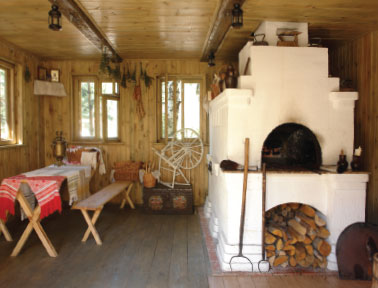The Heat Is On


The Romans are often given the credit for discovering how to heat floors and since heat rises the entire room. Called a hypocaust heating system from the Greek words meaning to “heat underneath ” in upper-class Roman homes and public baths the stone floors were raised several feet off the ground and perched on tile pillars
T here’s one in every house the room that stubbornly refuses to get warm. Maybe it’s because it’s under the roof or has a northern exposure or has a window that doesn’t quite fit its frame. Whatever the reason to enter the room is to be greeted with a blast of cold air — a shivery reminder of the way people once lived.
Truth to tell even our draftiest room would probably seem like heaven to our ancestors who braved the winds and snows of a typical Eastern European winter. Yet despite their lack of modern technology they managed to survive as did people who lived in chilly China and nippy New England. That’s because along the way people figured out how to keep their homes at least somewhat warm employing simple methods that we too can use in a stubbornly drafty room or to lower the heating bill.
Take the Floor
The Romans are often given the credit for discovering how to heat floors and since heat rises the entire room. Called a hypocaust heating system from the Greek words meaning to “heat underneath ” in upper-class Roman homes and public baths the stone floors were raised several feet off the ground and perched on tile pillars. Heat from a fire placed at one end of the room passed through the hollow space underneath the floor and heated the stones. Later the fire was moved to a separate furnace chamber — where it was kept going by slaves — and the heat was directed to the various rooms via a system of flues vents and ducts much like our modern central heating systems.
But despite the adage that “all roads lead to Rome ” archaeologists have also found early examples of hypocaust heating systems in Asia. And while the technology was lost in Europe after the fall of the Roman Empire in northern China and Korea variations of the kang (raised platform) heating system are still in use today.

A kang could cover the entire floor of a room in which case it was called a dikang but it more commonly covered just half or one-third of a room’s floor space. The fire came from a source such as the kitchen’s fireplace or stove and the heat was conducted into the room via a flue or shaft built to carry off the smoke. To take full advantage of the kang’s heated surface people would sit on the platform during the day instead of chairs and use low portable tables for eating their meals writing upon and playing board games. At night people would lay their bedding on the kang and have a cozy place to sleep. Of course without fuel a kang wouldn’t help as eighth-century Chinese poet Meng Jiao lamented long ago: “No fuel to heat the floor to sleep standing and crying with cold at midnight instead.”
Modern Take
If you don’t fancy tearing up your floors and installing a modern hypocaust heating system try this low-tech solution instead: an area rug. A good quality area rug can reduce the amount of heat needed to warm a room — especially a room situated above an unheated space such as a garage or basement — and act as a barrier between a cold floor and your feet. A thick rug with a high stitch count will insulate a room best. While wool is a top insulator cotton acrylic and nylon can also do the job. It’s preferable to cover most of the floor’s surface — one reason why wall-to-wall carpeting was once so popular — but if using one large rug isn’t practical several smaller rugs can also help keep a room warm.
Picture This
Anyone who has spent a winter in Jerusalem knows that those concrete walls found in most apartments can get cold. As for the massive stone walls of medieval castles, it’s hard to imagine anyone who lived in one in the winter complaining that a room was too hot. Fiberglass insulation wasn’t developed until 1932, so how did people who lived in stone or brick houses keep their interiors warm?
Actually, stone and brick will absorb the sun’s heat during the day — if there is sunshine — and slowly release that stored-up heat into the home after sunset. But that heat is rarely enough to warm up a large room on a frigid day. People therefore traditionally coped with poorly insulated walls by channeling their inner interior decorator. Tapestries, pictures, and mirrors were hung on walls to add a layer of insulation. Strategically placed portable screens and high-backed wing chairs were yet another way to protect family members from a draft. Exchanging lacey summer curtains for heavier ones — and keeping the curtains closed at night — was an effective way to counter drafts coming from windows and doors. And the four-poster bed was a cozy fortress against a winter night’s chill when the bed’s surrounding curtains were tightly drawn.
Another trick was to keep north-facing windows small and save the larger windows for a home’s south side, so both sunlight and heat could enter a room. Even landscaping was called into service; leafy trees in the yard could block the sun’s warming rays in the summer, while the bare boughs of winter would let the sun shine in when more heat was needed.
Modern Take
Even if you have double-glazed windows, closing curtains and blinds at dusk will help keep warm air in and cold air out; for particularly drafty windows, try adding an additional layer of fabric to your curtains, or even fleece, to double the protection. If you don’t have double-glazed windows, adding bubble wrap is an inelegant but effective way to keep out drafts. Use a spray bottle to dampen the window with water, cover the window pane with a cut-to-size piece of bubble wrap, then cover the window and frame with clear plastic, and seal it all with a removable sealant or silicone.
If you’re not big on decorating your home with pictures and mirrors, how about adding a well-stocked bookcase to a room? Like pictures and mirrors, the books will also act as an insulator. When positioning furniture in a room, try to put often-used items, such as a couch or bed, next to an internal wall, which will be warmer than an external wall and less drafty than a window. And be sure the furniture doesn’t block heat sources such as ducts or a radiator.
In the Hot Seat
If you read enough chassidic stories, eventually you will encounter a popular “character” of olden times, the Russian oven. During the day, the Russian oven was like any other oven; it was used to cook food and heat water for washing and bathing. But at night an elderly zeide or a young child might climb up on the oven’s ledge, which was usually the warmest place in the house, and settle down to a good night’s rest with a grateful sigh.
While a Russian oven would seem old-fashioned to us, it was a vast improvement over the earliest source of indoor heating, an open fire set up in the center of the family’s one-room dwelling. In theory, the fire’s smoke left the room via a smoke hole in the roof. The reality is that often the room was smoky. By the 13th century, fireplaces were common, but smoke remained a problem because of the chimney. Originally, chimneys were large so the chimney sweep could climb inside and clean it. The large size, though, meant cold air came down and created drafts —and prevented the smoke from escaping.
Around this time masonry stoves were also becoming common in northern and central Europe. Also known as a kachelofen or Russian stove or Russian oven, these large stoves are made from a material such as brick, stone, tile, stucco, or a combination, but not metals like steel or cast iron. A masonry stove takes longer to heat than one made from metal — it can take anywhere from five hours to two days to bring the stove to the right temperature, depending upon the stove’s size — but once hot, the masonry stove will radiate heat for much longer; some can still release heat up to 36 hours after the fire has gone out. Because a masonry stove could safely remain warm overnight, some were built with seats or had a bed adjoining them, or bedding could be placed on a ledge.
In Russian homes with more than one room, the stove was usually fitted into a wall. The front was in the kitchen, while the back formed part of the other room’s wall, so the hot bricks could warm the second room as well.
Although in theory a kachelofen or Russian oven could keep a house warm throughout Shabbos, families still usually employed a Shabbos goy to come in a few times throughout the day to check the oven and make sure the section keeping the cholent warm was working properly.
Eventually steam, coal, gas, and electricity became the preferred ways to heat a home. But in some parts of Europe, the energy-efficient kachelofen is still a popular way to keep a home warm.
Modern Take
Even if you can’t have a large masonry stove to heat your bedroom, think small and do what our ancestors did: Heat a soapstone, brick, or some rocks, wrap in a blanket or towel or put in a metal container called a bed warmer, and place under the covers so the bed will be nice and warm when you retire for the night. According to Vermont Soapstone, which has been selling bed warmers since 1856, you can heat their soapstones in a regular oven — but not a microwave — if you don’t have a wood-burning fireplace. A hot water bottle or warming cold sheets with a blow-dryer are other ways to remove the chill.
The radiator is another old-fashioned technology that was once used to heat the home. If your apartment still has them, here’s a trick to make them do an even better job: Hang tin foil on the wall behind the radiator. The foil will reflect the heat back into the room, rather than let it be absorbed into the wall. You can buy special reflective foil for this purpose, but any good quality foil will work.
Keeping It Cozy
Before modern heating systems became prevalent, some folks living in extreme climates followed the cue of the animal world and hibernated. For instance, the British Medical Journal reported in 1900 that Russian peasants living in the Pskov region slept away most of the winter months, rising only once a day to eat a little bread and make sure the fire was still lit.
A more common solution, if you lived in a multi-room dwelling, was to limit activity to just a few rooms of the house and block off the rest. The kitchen was always a popular place to gather, because a fire was usually burning in the stove or fireplace. In colonial America, houses also had a “keeping room.” Situated next to the kitchen and heated by the same fireplace, the keeping room was where families read, talked, told stories, sewed, knitted, and played games during those long winter nights. It later evolved into the “family room.”
People also beat the cold by warming the person, not the room. Wearing long underwear, warm socks, layers of turtlenecks and sweaters, and even hats, gloves, and scarves remains a great way to keep warm. Just add a hot cup of coffee, tea, or cocoa and you’re guaranteed to feel cozy, despite what the thermostat says.
Modern Take
One way to keep warm is to keep moving, even when you’re sitting. In other words, invest in a rocking chair. According to Tim Hutchful, of the British Chiropractic Association, when we’re not in motion, body temperature drops and muscles start to shiver. Rocking in a rocking chair uses large muscle groups in the legs, which keeps blood flowing. That, in turn, helps to generate more body heat. While everyone can benefit from a relaxing break in a rocking chair, it’s especially beneficial for the elderly and housebound, who may not have other forms of exercise to keep their circulation moving.
(Originally featured in Family First Issue 569)
Oops! We could not locate your form.






